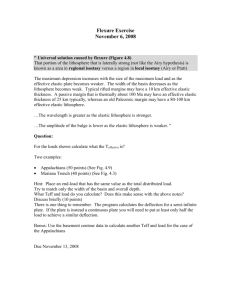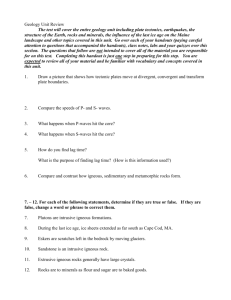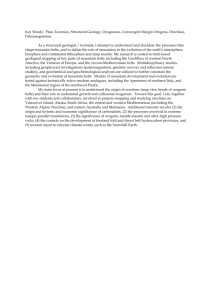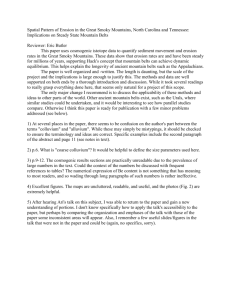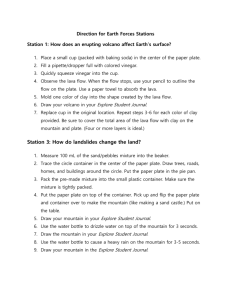Chapter 5: Mountain Belts and Continental Crust At this point in the
advertisement
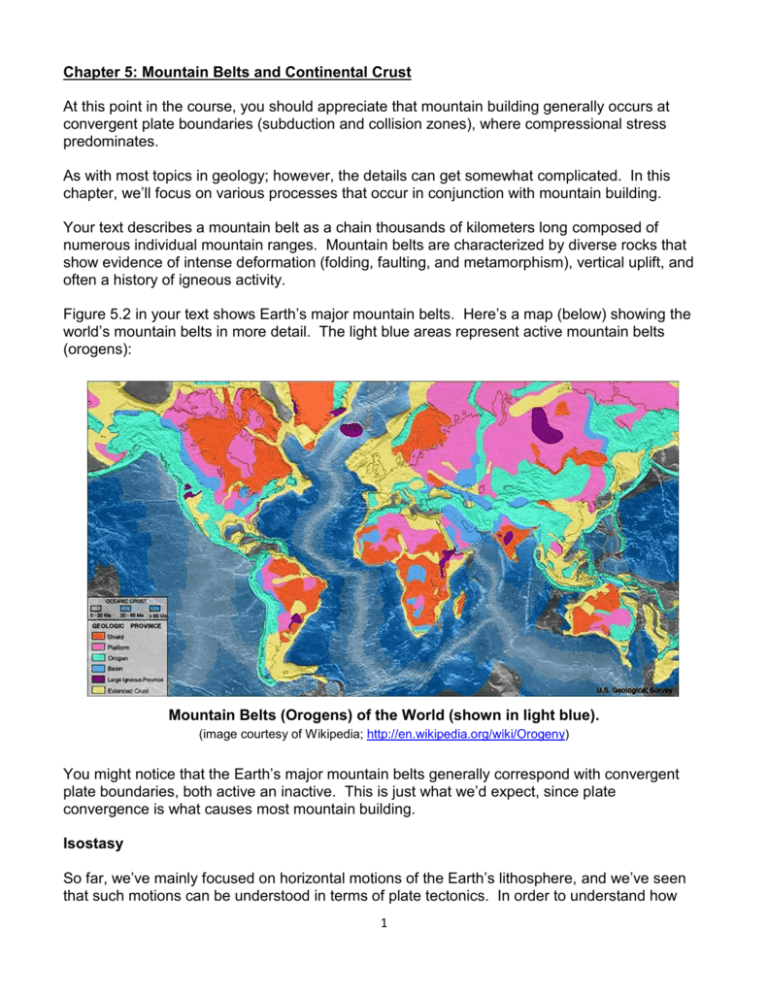
Chapter 5: Mountain Belts and Continental Crust At this point in the course, you should appreciate that mountain building generally occurs at convergent plate boundaries (subduction and collision zones), where compressional stress predominates. As with most topics in geology; however, the details can get somewhat complicated. In this chapter, we’ll focus on various processes that occur in conjunction with mountain building. Your text describes a mountain belt as a chain thousands of kilometers long composed of numerous individual mountain ranges. Mountain belts are characterized by diverse rocks that show evidence of intense deformation (folding, faulting, and metamorphism), vertical uplift, and often a history of igneous activity. Figure 5.2 in your text shows Earth’s major mountain belts. Here’s a map (below) showing the world’s mountain belts in more detail. The light blue areas represent active mountain belts (orogens): Mountain Belts (Orogens) of the World (shown in light blue). (image courtesy of Wikipedia; http://en.wikipedia.org/wiki/Orogeny) You might notice that the Earth’s major mountain belts generally correspond with convergent plate boundaries, both active an inactive. This is just what we’d expect, since plate convergence is what causes most mountain building. Isostasy So far, we’ve mainly focused on horizontal motions of the Earth’s lithosphere, and we’ve seen that such motions can be understood in terms of plate tectonics. In order to understand how 1 mountains are built, we also need to introduce an important process that accounts for much of the vertical uplift that characterizes mountain belts: isostasy. As defined in the glossary of your text, isostasy refers to the balance or equilibrium between adjacent blocks of crust resting on a plastic mantle. I prefer to think of isostasy as the buoyant equilibrium that exists between the lithosphere and asthenosphere, such that lithospheric plates float within asthenospheric mantle at an elevation that depends on both their thickness and density. Isostasy is such an important concept that it’s appropriate to delve into it in more detail. In the late 1800s, two different models of isostasy were developed, the so-called Pratt and Airy models. These two models are illustrated below: elevation 3.0* 2.7 2.6 2.7 3.0 *density in g/cm3 sea level 2.7* 2.7 2.7 2.7 2.7 Base of crust Airy Isostasy Model. Pratt Isostasy Model. In both the Pratt and Airy isostasy models (named after the folks who developed them), the elevation of the Earth’s surface is explained in terms of crustal blocks that float atop a plastic mantle. In the Pratt model, different surface elevations are understood in terms of crustal blocks of differing density. In this case, the blocks with lower densities float higher than those with higher densities, in the same way that a block of styrofoam floats higher in a swimming pool than a block of wood. In this model, the bottom of each block occurs at the same depth. In the Airy model, different surface elevations are understood to be the result of the different thicknesses of crustal blocks, with thicker crustal blocks sticking up higher and projecting downward more deeply than thinner ones. In this model, the depth to the bottom of each block differs from block to block. So…which model is correct? Both models, it turns out, are accurate in some respects but not in others. For example, the Pratt model explains in a very general way why the continents stick up higher above sea level than the ocean basins. Since continental crust is less dense than oceanic 2 crust, we’d expect it to ride higher atop the mantle than oceanic crust. This is just what the Pratt model of isostasy predicts. In other words, the continents are high and dry not just because they’re above sea level. Rather, the continents are elevated because they’re composed of rock types (e.g., granitic and metamorphic rock) that are more buoyant (less dense) than oceanic crust, which is mainly basaltic. But wait…in the Pratt model, notice that the base of the crust is the same everywhere. Seismic investigations later revealed that this just isn’t the case. In general, the base of the Earth’s crust beneath the continents (i.e., the Moho) occurs at a much greater depth than beneath the ocean basins. In the Airy model of isostasy, the depth to the crust-mantle boundary (Moho) varies, however, this model assumes that the densities of crustal rocks are everywhere about the same, which just isn’t the case. The Airy model predicts that regions of thickened continental crust should be associated with higher elevations, which generally is the case. The really important prediction of the Airy model is that Earth’s mountain belts should possess crustal roots (i.e., thicker crust that projects downward into the mantle like the root of a tooth). Seismic data confirm that the world’s major mountain belts such as the Himalaya are indeed underlain by thicker crust. By the way, an easy way to remember the basic difference between the Pratt and Airy models is the phrase, “Pratt is flat but Airy varies.” Currently, the preferred model of isostasy applies to the lithosphere and asthenosphere and combines aspects of both Pratt and Airy. In essence, we now recognize that continental lithosphere rides higher atop the mantle than oceanic lithosphere because it’s both thicker and less dense (Pratt); also, the depth to the base of the crust and lithosphere varies from place to place, and many of Earth’s mountain belts are underlain by lithospheric roots (Airy). An historical note: You might remember from the chapter on plate tectonics that Alfred Wegener’s theory of continental drift wasn’t widely accepted by his contemporaries, particularly geologists in North America. One reason for this may have been that North American geologists in the 1920s and 1930s were reluctant to abandon their oversimplified understanding of isostasy. As U.C. San Diego scholar Naomi Oreskes discusses in her book, The Rejection of Continental Drift: Theory and Method in American Earth Science (Oreskes 1999), the Pratt model of isostasy was generally preferred by geologists in North America over the Airy model because it was easier to work with. As mentioned above, a prediction of the Pratt model is that the depth to the base of Earth’s crust should everywhere be the same; however, Wegener argued that the leading edges of the continents were thickened as they drifted across the globe. Wegener’s critics in turn argued (quite correctly) that thickened continental edges would imply a variable depth to the base of the crust—a conclusion clearly at odds with Pratt isostasy. The result is that Wegener’s critics rejected his ideas in part because they were incompatible with Pratt isostasy. In effect, they rejected Wegner’s ideas rather than rethink their commitment to Pratt isostasy. In the end, Wegener’s prediction that drifting continents become thickened at their leading edges has been upheld (although for different reasons that Wegener suggested), whereas the Pratt model of isostasy has been falsified. Score one for our hero, Alfred Wegener . 3 Large vertical motions of the lithosphere occur when the lithosphere is out of isostatic balance with the underlying asthenosphere. In general, mountain belts develop in response to lithospheric thickening. Such thickened lithosphere creates an isostatic imbalance. In response, the lithosphere within a mountain belt typically rises to counteract this imbalance (Figure 5.15). The lithosphere can also move vertically downward if loaded from above. For example, when thousands of meters of ice accumulate on a continent during an ice age, the lithosphere of the continent sinks in response. When the ice age ends and the glacial ice melts, the lithosphere rises in response. Here’s a simple animation of Isostasy—Figure 5.14. Although it may seem counterintuitive, erosion also leads to isostatic rise. As a mountain belt erodes, the lithosphere rises in response due to unloading, although usually not up to its former elevation, as shown here: Erosion (triggers isostatic rise) Deposition (triggers isostatic subsidence) Deposition (triggers isostatic subsidence) LITHOSPHERE ASTHENOSPHERE Erosion, Deposition, and Isostasy. Let’s consider some specific plate tectonic settings where mountain belts develop: Ocean-Continent Convergence (plate subduction)—marginal, “Andean-type” mountain belts Figure 5.6 shows a geologic cross section through a typical “Andean-type” mountain belt. Here’s a simplified sketch (next page): 4 Isostatic rise due to magmatic underplating + erosion Accretionary Wedge Trench Sea Surface Volcanic/Magmatic Arc Fold / Thrust Belt Forearc Basin Rising magma Crust and lithosphere thickened underneath via magmatic underplating Isostatic subsidence due to sediment loading within forearc basin Simplified cross section through an Andean-type mountain belt. Next to the trench, we find a complexly folded and faulted region called the accretionary wedge, where seafloor rocks from the subducting plate are being scrapped off and plastered onto the non-subducting plate. Thrust and reverse faulting along with intense shearing characterize accretionary wedge rocks. As you might imagine, the rocks within an accretionary wedge are highly deformed and mixed up—they’ve been through a lot! In fact, a rock called “mélange” is commonly found in accretionary wedges. Mélange consists of a complex mixture of various rock fragments jumbled together in a matrix of sheared, fine-grained mudrock. Here’s a photo of mélange from an ancient subduction zone in the Appalachian Mountains. Notice the large rock fragments surrounded by fine-grained mudrock. Notice, too, how sheared and broken up this stuff is. Think of it as tectonic gobbledygook! Here’s another photo of some mélange from the Franciscan subduction complex, near San Francisco, CA: 5 Melange with Chert Clasts, Marin Headlands, CA. Image courtesy of Bruce Molina, United States Geological Survey Image source: Earth Science World Image Bank (http://www.earthscienceworld.org/images) Moving landward from the accretionary wedge, we encounter an elevated region called the volcanic / magmatic arc. This is where igneous activity is most intense. Intrusive igneous rocks are being emplaced at depth, whereas volcanic rocks of generally intermediate composition are erupting at the surface, creating large stratovolcanoes. The lithosphere is thickest beneath the volcanic / magmatic arc due to addition of vast amounts of hot, buoyant magmatic material to the underside of the arc as this material rises from near the subducting plate, in effect, thickening the lithosphere from below. Your textbook authors refer to this process as magmatic underplating. Isostatic rise associated with the thickened lithosphere of the magmatic arc creates tall mountains (Figure 5.6). Here’s a photo (below) of the mighty Sierra Nevada, a northwest trending mountain range in eastern California. Most of the rocks in the Sierra are granitic rocks that formed within a Mesozoic-age volcanic / magmatic arc east of an ancient subduction zone that once existed just offshore of central and southern California: Sierra Nevada Mountains. (photo courtesy of Wikipedia; http://en.wikipedia.org/wiki/Sierra_Nevada_(U.S.) 6 In between the accretionary wedge and the magmatic arc is the forearc basin, which receives vast amounts of sediment eroded from the magmatic arc and sometimes also the accretionary wedge. Sedimentary rocks within the forearc basin are much less deformed than those in the accretionary wedge. As more and more sediments are added to the forearc basin, isostatic subsidence occurs, making room for still more sediments (Figure 5.6). Thus, the forearc basin sinks isostatically (due to loading from above), whereas the magmatic arc rises (due to thickening from underneath). So, to summarize, Andean-style mountain belts are characterized by a deep trench, a complexly folded and faulted accretionary wedge adjacent to the trench, a forearc basin inboard from the trench, and a volcanic / magmatic arc inboard from the forearc basin. In some cases, a fold and thrust belt develops landward of the arc, where layered rocks are horizontally shortened, stacked on top of each another like shingles, and thrust toward the continent in response to compressional stress associated with ocean-continent plate convergence (Figure 5.6). A good example of a subduction-related fold and thrust belt is the northern Rocky Mountains, where gigantic stacks of sedimentary rock have been thrust eastward where the Earth’s crust has been crunched together like a bunch of shingles or dominoes. The origin of the Rocky Mountains has been a perplexing problem for geologists because the Rockies are so far inland from the Andean-type subduction zone that persisted along the west coast of North America throughout Mesozoic and into Cenozoic time. In a typical subduction zone, the subducting plate slides beneath the non-subducting plate at a fairly steep angle; however, in late Mesozoic time, the angle of the subducting plate may have been significantly flattened, shifting the focus of mountain building processes (e.g., magmatism, compressional faulting) far inland. The geology of central California fits the Andean-style subduction model quite well. Along the central California coast, the Coast Ranges, including the Diablo Range east of San Francisco and the Santa Cruz Mountains, consist of an intensely deformed mixture of various rock types of mostly oceanic affinity known collectively as the Franciscan Complex. With the development of plate tectonic theory, geologists recognized that Franciscan rocks correspond to Mesozoic-age accretionary wedge deposits. Moving east, California’s Central Valley region is underlain by thick sequences of relatively undeformed marine and non-marine sedimentary rocks that accumulated within a Mesozoic forearc basin. Finally, the Sierra Nevada mountains east of the Central Valley represent the remains of a Mesozoic volcanic / magmatic arc. Known collectively as the Sierra Nevada batholith, Sierran 7 granitic rocks are the cooled, crystallized remains of ancient magma chambers that once fed an active volcanic arc. Here’s a sketch to help you visualize these relationships: Volcanic / Magmatic Arc (Sierra Nevada Batholith) Accretionary Wedge (Franciscan Complex) Forearc Basin (Great Valley Sequence) California’s geomorphic provinces. Image courtesy of California Geologic Survey http://www.conservation.ca.gov/cgs/geotour/Pages/Index.aspx Before plate tectonic theory came along, geologists had a hard time making sense of Franciscan rocks in particular. How could such a complex, intensely deformed group of rocks have developed? With the advent of the plate tectonic model, the complexity of Franciscan rocks began to make sense. In effect, Franciscan rocks represent material scraped off an ancient, now-subducted oceanic plate and plastered onto the edge of the North American plate. 8 Arc-Continent Convergence (terrane accretion) Imagine an old island arc, embedded in an oceanic plate, moving toward a subduction zone (Figure 5.11A). When the island arc reaches the subduction zone, it can’t subduct due to its high buoyancy, and it eventually clogs the subduction zone. With continued compression, a new subduction zone may be initiated seaward of the arc, and the arc eventually becomes plastered onto the edge of the continent (Figures 5.11B and C). When this happens, the island arc is effectively welded onto the edge of the non-subducting plate, causing the plate to grow laterally—a process called terrane accretion. Here’s an interesting animation of the accretion process. A terrane is a fault-bounded package of rocks that have a different geologic history than the rocks in adjoining regions. Notice the variant spelling. A terrane is an accreted, tectonic sliver, whereas the word, terrain, simply refers to the character of the land (e.g., hilly vs. flat terrain). Island arcs can become terranes. So can sea floor rocks, accretionary wedge rocks, and even entire microcontinents. If a terrane originates from far away, it’s often referred to as exotic by geologists to remind us that the rocks we’re looking at came from someplace else. Much of the land in North America west of the Rocky Mountains, including most of Alaska, is thought to be composed of exotic terranes that have been accreted to the North American plate since Mesozoic time. Both ocean-continent convergence and arc-continent convergence (terrane accretion) create mountain belts near plate edges. Speaking of accreted terranes, here’s a photo of North America’s tallest peak, Mt. McKinley. I shot this from a small plane on a visit to Alaska several summers ago: 20,320 ft Mt. McKinley (Denali). 9 Mt. McKinley (or Denali, as the Athabascans call it) is part of the Alaska Range and consists of 56 million year-old granitic rock that was intruded into older, exotic island arc terranes during their accretion onto the North American plate. Denali is still rising at about 1 mm/year, pushed up by compressional tectonics and isostatic rise associated with nearby subduction of the Pacific plate beneath Alaska. Continent-Continent Convergence (plate collision)—interior, “Himalayan-type” mountain belts Mountain belts found within plate interiors as opposed to plate edges are thought to be the result of continent-continent convergence, where two continental plates collided and welded together to become one. The Alps, Urals, Appalachians, and Himalayas are all examples of mountain belts formed by plate collision. In such settings, compressional stress and associated horizontal shortening can be intense, as shown in Figure 5.13, a cross section through the Alps. Like subduction zones, the lithosphere at collision zones becomes thickened, but in a different way than at subduction zones. Instead of becoming thickened from underneath by the addition of hot, buoyant magma, lithospheric thickening at collision zones occurs primarily by horizontal shortening, folding, and stacking of thrust sheets, one atop another (Figure 5.13). As the lithosphere thickens, its isostatic balance is upset, and isostatic uplift occurs as a result. The lithosphere beneath the Himalayas is approximately 200 km thick, about as thick as anywhere on Earth, where the Indo-Australian plate is attempting (unsuccessfully) to subduct beneath the southern portion of the Eurasian plate, effectively doubling up lithospheric thickness in this region. Here’s a simple sketch of a typical collision zone (“Himalayan-type” mountain belt): Suture Zone (plate boundary) Horizontal shortening and compressional faulting Young mountain belt (e.g., Himalayas, Alps) Continental lithosphere Continental lithosphere Cross section of a collision zone. (continent-continent plate convergence) 10 In the above diagram, the lithosphere is thickened beneath the mountain belt as a result of accordion-style, horizontal shortening. At shallow depths within the crust, where the rocks are cool and brittle, thrust and reverse faulting predominate. At greater depths, where the rocks are warmer and more plastic, regional metamorphism and folding occur. Post-Orogenic Uplift and Block-Faulting You can just skim this section of Chapter 5. I won’t hold you responsible for this material. Continental Growth This last section of Chapter 5 discusses how continents evolve. As your text states, “Continents grow bigger as mountain belts evolve along their margins.” Hopefully by now you can appreciate how amazing this simple statement really is. Not only can plate tectonic processes like subduction, terrane accretion, and collision explain the growth and development of mountain belts, such processes can explain how the continents themselves grow! Nowhere is this better illustrated than along western North America, where dozens of large and small, fault-bounded slivers of continental and oceanic crust (terranes) have been mapped in recent years. In effect, much of North America can be thought of as a collage of accreted, exotic terranes. San Diego itself is built atop a 100-million year old exotic island arc terrane. The exposed granitic rocks in the greater San Diego area formed in an ancient island arc that once lay perhaps thousands of kilometers offshore. Eventually, these rocks were accreted onto the leading edge of the North American plate. There’s a very famous fault zone (famous among geologists, anyway ), the Cuyamaca-Laguna Mountain Shear Zone, just east of I-8 near Sunrise Highway, that marks the eastern boundary of this terrane. What is true of western North America is probably also true, to some extent, of most other continents as well: the continents grow larger by terrane accretion as geologic time progresses. Eventually, they collide, creating supercontinents like Pangea. Following this, the supercontinents break up to repeat the cycle all over again. Here’s a link to a fascinating New York Times article where you can scroll through various plate configurations from 200 million years ago to 250 million years in the future, when the next supercontinent, dubbed Pangea Ultima, may form…Wow! References Cited: Oreskes, Naomi. 1999. The Rejection of Continental Drift: Theory and Method in American Earth Science. Oxford University Press. 11

